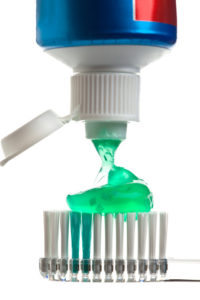Toothpaste 101: What’s in toothpaste?
Everyday you brush your teeth at least twice a day, but do you really know what you’re using to brush your teeth with? In today’s market, there are many toothpaste selections with diverse flavors claiming to whiten teeth, control teeth sensitivity, care for gums, and even freshen breath. Let’s take a look at some of the common ingredients and how toothpaste can be different.
Common toothpaste ingredients
Fluoride
Fluoride is the most popular active ingredient in toothpaste. It can be listed as sodium fluoride, sodium monofluorophosphate or stannous fluoride. Fluoride strengthens teeth by remineralizing the enamel to prevent cavities and reduce wear by acidic foods. Only toothpastes containing fluoride are able to meet the American Dental Association’s (ADA) requirements to reduce tooth decay and be eligible to earn the ADA Seal of Acceptance.
Glycerol
Glycerol, also known as glycerin or propylene glycol, work to prevent water loss. It gives toothpaste a consistent texture to make it easier to dispense from the tube.
Sorbitol
Sorbitol is used as a sweetener to improve taste and also prevent dehydration in toothpastes. Unlike sugar, sorbitol does not cause cavities and is a non-caloric sweetener. Saccharin is another sweetener in toothpastes.
Calcium carbonate
Calcium carbonate is the common abrasive used in toothpastes to clean surfaces of your teeth. Other types of abrasives are dehydrated silica gels, hydrated aluminum oxides, magnesium carbonate, phosphate salts, and silicates. These abrasives are rough enough to help remove plaque, debris and surface stains, but gentle enough to avoid damaging the enamel.
Sodium lauryl sulfate
One of the most common detergents placed in toothpastes is sodium lauryl sulfate. Detergents are used in toothpastes to provide foaming during brushing and help remove plaque, debris and surface stains.
Toothpaste options
Whitening
The whitening agents in toothpastes remove surface stains, and cannot change the natural color of teeth or remove discoloration. To remove surface stains, whitening toothpaste may include abrasives to polish the teeth or additives like peroxide to dissolve stains. Whitening toothpaste takes about three weeks to see a difference. An alternative to using whitening toothpaste can be teeth whitening treatments.
Desensitizing
For sensitive teeth, you may consider using toothpaste with a desensitizing or antihypersensitivity agent to reduce sensitivity. Examples of these ingredients are potassium salts, stannous fluoride, and amorphous calcium phosphate.
Antimicrobial
Some toothpaste include ingredients that can kill bacteria that develop into plaque, gingivitis, and bad breath. Antimicrobial agents like stannous fluoride and triclosan can help reduce gingivitis, where as pyrophosphates and zinc citrate can reduce the build-up of plaque and tartar.
Are you looking to get your teeth cleaned? Are you interested in learning about teeth whitening options? Then contact California Dental Group at (800) 407-0161 to set up an appointment.





